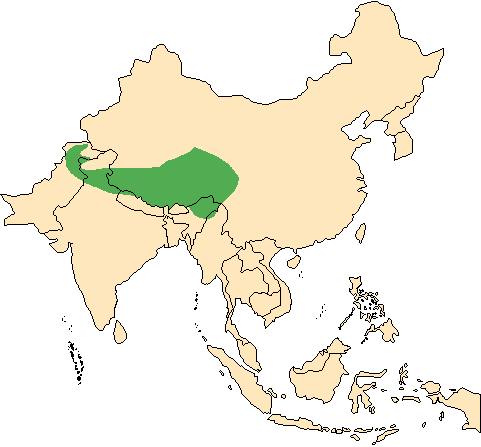![]() Return
to Artiodactyla
Return
to Artiodactyla
Classification
|
![]() Moschus
chrysogaster
Moschus
chrysogaster
Himalayan musk deer
![]()
Taxonomy
General Characteristics
Body Length: 86-100 cm / 2.8-3.3 ft.
Shoulder Height: 51-53 cm / 20-21 inches.
Tail Length: 4-6 cm / 1.6-2.4 inches
Weight: 11-18 kg / 24-40 lb.The general colour of the coat, composed of brittle hairs, is a slightly grizzled sandy brown. As the name suggests, on the chest is a wide vertical whitish-yellow stripe which extends up the throat to the chin. The ears are tipped with yellow or orange hairs. On the nape of the neck are several horizontal blotches of yellowish hairs. The body slopes forward, as the hind legs are almost one third longer than the forelegs, causing the height at the rump to be almost 10 cm / 4 inches above the shoulder. The ears are large and rounded, generally lined with whitish fur. Both sexes have well-developed upper canines, and in males these grow 7-10 cm / 3-4 inches long and protrude from the mouth in a fang-like manner. The canines are constantly growing, but, due to their mobility and fragility, they are easily broken. There are no antlers in this, as well as other musk deer, species.
Ontogeny and Reproduction
Gestation Period: 185-195 days.
Young per Birth: 1, usually 2.
Weaning: 3-4 months.
Sexual Maturity: 16-24 months.
Life span: 12-20 years.Breeding occurs primarily in November-December, with the resulting being born from May to June. After birth, the young deer lie hidden in secluded areas, essentially independent of their mothers except at feeding times. This hiding period may last up to 2 months.
Ecology and Behavior
Himalayan musk deer are most active between dusk and dawn, alternately resting and feeding throughout this period. At night, musk deer can be seen in the open areas of their habitat as they graze, while during the day, they remain in dense cover. Neighbouring individuals may utilize common latrines, an activity with becomes more frequent during the mating season. Himalayan musk deer are sedentary, remaining wthin a defined home range throughout the year. In females these are about 125 acres in size, while male musk deer will control a territory which encompasses the ranges of several females, defending it against intrusion by rival males. The Himalayan musk deer does not undertake any seasonal migrations, remaining in the same area year-round despite harsh weather conditions. A shy animal, the musk deer depends on its sense of hearing to locate sources of danger. When frightened, they make broad leaps, each measuring up to 6 meters / 19 feet in length. Drastic changes in direction are made during flight, and every few jumps the animal will stop and listen. Communication between individuals is thought to be based primarily on their sense of smell, due to the high development of the glands of musk deer. Primarily silent, musk deer will emit a loud double hiss if alarmed, and may scream plaintively if wounded. Population densities are about 3-4 animals per square kilometer.Family group: Solitary.
Diet: Leaves, grasses, moss, lichens, shoots, twigs.
Main Predators: Yellow-throated marten, fox, wolf, lynx.
Distribution
Alpine forest and scrub at elevations of 2,200-4,300 meters / 7250-14,200 feet on the eastern and southern edge of Tibet and the southern slopes of the Himalayas.

Range Map (Redrawn from Whitehead, 1993)
Conservation Status
As a species, the Himalayan musk deer is classified as low risk, near threatened by the IUCN (1996). M. c. chrysogaster and M. c. leucogaster are both classified as low risk, near threatened subspecies.
Remarks
The specific name sifanicus is sometimes used in place of chrysogaster. The most primitive of the cervids, musk deer have sometimes been placed in their own family, as their morphology is half-way between chevrotains and the true deer. The musk produced by this genus of primitive deer is highly held for its cosmetic and alleged pharmaceutical properties, and can fetch U.S. $45,000 per kilogram (2.2 pounds) on the international market. Although this musk, produced in a gland of the males, can be extracted from live animals, most "musk-gatherers" kill the animals to remove the entire sac, which yields only about 25 grams (1/40 of a kilogram) of the brown waxy substance. Moskhos (Greek) musk, also moschus (New Latin) musk. Khrusos (Greek) gold; gaster (Greek) the belly.
Literature Cited
Green, M. J. B. 1987. Some ecological aspects of a Himalayan population of musk deer. In Biology and Management of the Cervidae. Edited by C. M. Wemmer. Washington, D. C.: Smithsonian Institution Press. pp. 307-319.Nowak, R. M. [editor]. 1991. Walker's Mammals of the World (Fifth Edition). Baltimore: The Johns Hopkins University Press.
Sheng Helin, Noriyuki Ohtaishi, and Lu Houji. 1999. The Mammalian of China. Beijing: China Forestry Publishing House.
Whitehead, K. G. 1993. The Whitehead Encyclopedia of Deer. Stillwater, MN: Voyageur Press, Inc.
Wilson, D. E., and D. M. Reeder [editors]. 1993. Mammal Species of the World (Second Edition). Washington: Smithsonian Institution Press. Available online at http://nmnhwww.si.edu/msw/
Zhiwotschenko, V. 1990. Musk Deer. In Grzimek's Encyclopedia of Mammals. Edited by S. P. Parker. New York: McGraw-Hill. Volume 5, pp. 133-136.
Return to Artiodactyla

![]()
© Brent Huffman, www.ultimateungulate.com |
|
|